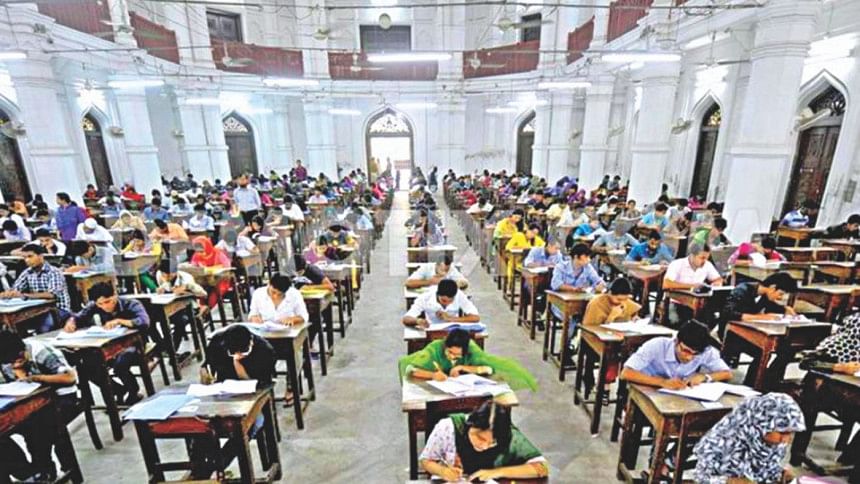Why are university graduates failing to meet market needs?

With 41 public and 103 private universities having more than three million students (around 28 lakh students in public universities and 3.37 lakh students in private universities as per the Annual Report 2016 of the UGC)—greater than the population of some countries—Bangladesh's tertiary education system is one of the most overcrowded in the world. However, the highly educated in the country have fewer chances of employment today.
A Dhaka based non-government organisation known as the Center for Development and Employment Research (CDER) published a report titled "Bangladesh Employment and Labor Market Watch 2018" which shows that youth unemployment rate in Bangladesh is the highest among graduates with a tertiary degree. The unemployment rate among those with graduation and post-graduation degree rose to 16.4 percent in 2013 compared to 9.9 percent in 2010 (Bangladesh Employment and Labor Market Watch 2017). Even though the rate came down to 12.1 percent in 2016, a significant percentage of the highly educated youth are still unemployed (Bangladesh Employment and Labor Market Watch 2018).
The Annual Report 2016 (the latest annual report found in UGC's website) reveals that 34 public universities and 95 private universities excluding the colleges affiliated with the National University, Open University and Islamic Arabic University are providing tertiary education to some 601,241 students. According to the report, 125,131 students have been enrolled under arts and humanities and social science disciplines, 150,577 students under science, 12,627 students under pharmacy, 10,300 students under medical, 24,188 under agriculture, 152,214 under engineering and technical disciplines, 147,714 students under business studies, 4,650 students under education, 31,222 students under law, and 15,806 students under diploma/certificate programmes and other courses.
What is more, the National University alone is providing tertiary education to some 2,300,053 students which is about nine times that of 34 public universities combined and seven times that of 95 private universities. Some 668,824 students are under arts and humanities, 745,025 students under social science disciplines, 215,441 students under science, agriculture, medical and technical disciplines, 650,608 students under business studies, 512 students under education, 14,819 students under law, and 4,824 students under diploma/certificate programmes and other courses (Annual Report 2016, UGC).
There are four major approaches to educational planning: social demand approach, social justice approach, rate of return approach and manpower planning approach.
The social demand approach is more prevalent in the planning of primary, secondary and higher secondary level education through which the government makes decisions regarding schools and facilities for all students who demand admission.
Tertiary education is strongly vocationally or professionally oriented and requires adequate financial, academic and human resources. The manpower planning approach, on the other hand, prioritises human resources using the limited financial resources in an optimum way so as to produce students who can fulfil the demands of the employment sector.
It seems the country is following the social demand approach instead of the manpower planning approach in the development of tertiary education. The report of the UGC proudly mentions that the number of seats available in tertiary education institutions is higher than the number of students passing the higher secondary level.
However, the unfortunate reality is that graduates coming out of the conventional education system cannot meet the demands of today's world of business and development. The training given to students in universities is not focused on the industry's requirements. As a result, corporate bodies and factory owners are forced to bring in personnel from overseas. They allege that there exists a dearth of technical, professional and language skills that are regarded as prerequisites in the fast-changing job market in the era of the fourth industrial revolution.
Many foreigners are currently working in different multinational companies, readymade garment companies, pharmaceutical companies or in other economic sectors in Bangladesh. Home Minister Asaduzzaman Khan Kamal gave an account in the parliament back in February 2018 of how many foreigners work in Bangladesh. According to his estimates, some 85,486 foreigners work in the country and around half of them are Indians (Prothom Alo, April 17, 2018).
Foreigners mainly work in the production management of factories, management of machinery, quality control and mid-level management of organisations. Many foreigners also work in merchandising and buying houses of the readymade garment sector. Besides they work in the technical and product manufacturing process in export processing zones. Along with this, foreigners are sometimes hired for the post of managing director and director of major MNCs in Bangladesh. According to a recent study by the Centre for Policy Dialogue (CPD), foreigners are working in 24 percent of garment factories in the country. More than 70 percent of managerial posts of organisations in the plastic industry have been given to foreign nationals.
RMG, foreign remittance, and agriculture are considered key sectors of the economy. All three sectors more or less hinge on unskilled and semi-skilled manpower. Experts and economists have already begun to sound alarms about China's massive investments in capacity building and infrastructure development projects integrating RMG industries in African countries which may create challenges for Bangladesh's RMG in the near future. Moreover, the economic consequences of the Arab Spring have already proved to be one of the biggest threats to the country's international remittance share.
At a time when the country is facing a certain level of "credential inflation" (devaluation of educational or academic credentials over time and a corresponding decrease in the expected advantage for a degree-holder in the job market) in arts, humanities, social sciences, business studies, and other disciplines, sectors such as RMG, plastic, manufacturing industries, medical, education, ICT and development lack skilled human resources.
In today's world, the role of universities cannot only be limited to imparting knowledge but it must also introduce job-oriented curricula and skills-based training in order for students to be successful in their careers. Traditional graduation programmes should prepare young people for the job market—both in Bangladesh and abroad.
Universities should identify the skills that are required by corporate bodies for employability both at home and abroad. Universities should equip their students with these skills, attitudes and abilities so that graduates are confident going into the job market. More experimentation and research are needed to identify the shortcomings in university curricula in order to make tertiary education more effective in creating skilled manpower. The gap between education and employment can be closed through employer engagement in education and training. In order to address these challenges, the government and other stakeholders need to establish a close link between employers and universities.
Khalid Hasan is a graduate student of the Department of Educational Administration at the Institute of Education and Research, Dhaka University.





Comments